Baryancistrus demantoides
Baryancistrus demantoides was officially described in 2005 by Werneke, Sabaj & Lujan. The genus name Baryancistrus can be divided into two parts. From ancient Greek barys meaning heavy and Ancistrus, summarized something like Heavy Ancistrus. The word Ancistrus comes from the Greek word “agkistron” and means “fishhook” which refers to their hooked interopercular odontes.
In shops and websites some common names are used: Lemon Spotted Green Pleco, Green Pleco, L200
Origin
South America: upper reaches of the Rio Orinoco, from Minicia to the Rio Ventuari and the Rio Ventuari, border area of Venezuela and Colombia.
Maximum size
About 20cm.
The Aquarium
This medium-sized catfish prefers a dimly lit aquarium with plenty of hiding places, in the form of plants, driftwood, rocks and/or artificial caves. To keep multiple specimens of this species, or to keep this species with other bottom dwellers, an aquarium of 120×50 centimeters or larger is required, as the species can be quite territorial. With a lack of suitable hiding places or insufficient space, they can behave particularly aggressively towards other bottom dwellers. If it is the only bottom dweller in the aquarium, an aquarium of 100x40cm is sufficient, although an aquarium of 120 centimeters is ideal. Juveniles can be kept temporarily in smaller aquariums without any problems, as long as there are sufficient hiding places.
This species requires warm and highly oxygenated water, preferably soft and slightly acidic to neutral in composition. A good amount of current is also appreciated. A strong filter is important, as this fish produces a lot of waste.
Diet
Given the large sucking mouth of the Baryancistrus demantoides, covered with many very small teeth, this species is a so-called “Aufwuchs” eater. Aufwuchs is the organic layer, partly vegetable, partly consisting of small organisms (crustaceans, freshwater sponges, small insects, insect eggs and larvae, and plankton), which forms on submerged surfaces over time, and which these armored catfish graze off.
Once acclimatized, Baryancistrus demantoides is not very picky, and in most cases, it will eat both meat food (mosquito larvae, bloodworms, tubifex, artemia, etc.) and vegetable food (blanched vegetables, tablets, algae, and, to the dismay of many aquarists, including aquarium plants). The emphasis should be on vegetable food, as it is closer to the natural diet, and because a diet that is too high in protein can lead to digestive problems, blockages, and even death.
Character
Suitable for a community aquarium, but can be very aggressive towards other armored catfish, other L200 in particular. This species is in fact fairly territorial: finding and maintaining caves, suitable for building a nest, is usually the stumbling block. More than one L200 in a cramped aquarium or in an aquarium with insufficient adequate hiding places can result in the death of one or more fish, although they can certainly be kept together in a spacious tank with lots of decoration.
Comments
Baryancistrus species are notorious for the difficulty of acclimatization: a significant proportion – over 50% in some species – of imported specimens from this genus die during the first month in captivity due to stress and malnutrition. Another problem of recently imported specimens is the deterioration of the intestinal bacterial flora, which has been disrupted by transport (resulting in digestive problems and a strongly reduced absorption of extremely important nutrients, especially during the first weeks). Fish offered in stores must have been quarantined at the importer/trader for a minimum of several weeks to ensure reasonable survival rates. This is not the case with fish with sunken eyes and abdomen, and unfortunately, more often than not, the animals will die within a few weeks.
Once home, this fish must be kept in a quarantine aquarium for a number of weeks to allow the animal to get used to life in captivity and the local water parameters. During this period it should also be checked whether the catfish is eating well: depending on the food offered, red to dark brown colored thin, solid strings of feces (also called spaghettis by hobbyists) should be found in the aquarium, as a sign that they eat the food. In addition, it can be determined which types of food are accepted and which are not.
Once the fish is eating well, is active and alert, and looks healthy (good coloring, round belly, slightly bulging, clear eyes), it can be moved to a larger aquarium.
But the problems don’t stop there: however vulnerable Baryancistrus species may be during the first weeks, once acclimatized it is often a completely different story. Once the fish is used to its new environment, it will claim a territory, and also defend it against intruders. Congeners in particular are not tolerated, but other bottom dwellers can also have a hard time. Fights can be quite fierce, and in some cases, it is advisable to separate the fish to avoid unnecessary stress and injury. However, with the help of sufficient hiding places and breaking lines of sight, the territory problem can usually be solved without the need to move one or more fish.
Additional information
Baryancistrus demantoides is known among hobbyists as L200 “Hi-Fin”: firstly because of its enormous dorsal fin, and secondly to differentiate it from the other L200 variant with a ‘normal’ dorsal fin. These two variants are found in the same area, and it was initially assumed that they were one and the same species. But in 2005, the L200 was scientifically described, and that research revealed, among other things, that they are two different species. The species depicted here with the particularly high, shark-like dorsal fin is Baryancistrus demantoides, the species with the normal dorsal fin is Hemiancistrus subviridis, which is more related to the – as yet undescribed – L128 Blue Phantom Pleco (also a Hemiancistrus species) .
Video
Authors
Jonas Hansel – Piranha-info.com
John de Lange
Copyright images
Jonas Hansel – Piranha-info.com











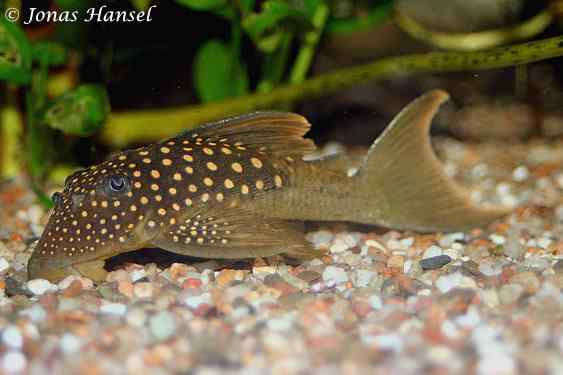



























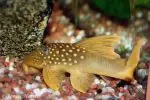






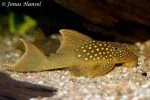









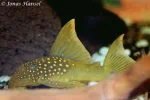
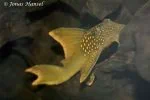
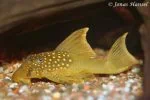

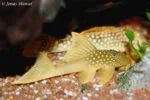


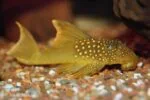






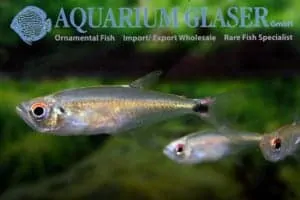




Reviews
There are no reviews yet.